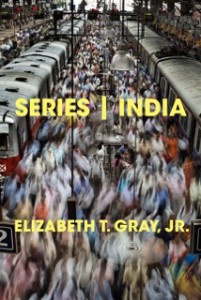 ELIZABETH T. GRAY JR. is a poet, translator (of classical and contemporary Persian), and corporate consultant. Her collection of poems, SERIES | INDIA was published by Four Way Books in April 2015. She has been nominated for a Pushcart Prize, and her work has appeared in Little Star, Talisman, The Kenyon Review Online, New England Review, Ploughshares, Poetry International, The Harvard Review, Mantis, Beloit Poetry Journal, Best New Poets 2012, and elsewhere. She has a B.A. and J. D. from Harvard University and an M. F. A. from Warren Wilson College. www.elizabethtgrayjr.com. (Photo credit: Susan Johann.) ELIZABETH T. GRAY JR. is a poet, translator (of classical and contemporary Persian), and corporate consultant. Her collection of poems, SERIES | INDIA was published by Four Way Books in April 2015. She has been nominated for a Pushcart Prize, and her work has appeared in Little Star, Talisman, The Kenyon Review Online, New England Review, Ploughshares, Poetry International, The Harvard Review, Mantis, Beloit Poetry Journal, Best New Poets 2012, and elsewhere. She has a B.A. and J. D. from Harvard University and an M. F. A. from Warren Wilson College. www.elizabethtgrayjr.com. (Photo credit: Susan Johann.) |
 Book Title, Press, Year of Publication:
Book Title, Press, Year of Publication:
SERIES | INDIA, Four Way Books, 2015.
Synopsis: The linked lyrics in SERIES | INDIA explore the rich borderlands between the familiar and the foreign, illumination and opacity, love and death, and gods and charlatans, through a braided, sometimes unstable, arc of narratives of young Westerners in India.
What do you think makes your book (or any book) a “project book”?
I think there are two different questions embedded here: (1) Is the end product a “project book”? and/or (2) Was the process (by which the book came to be) thought of, at the outset, as a “project”? As qualified, let me answer each of these questions in turn.
I would view the finished book, SERIES | INDIA, as “project book.” The poems trace an arc (with variations and alternatives) of a single story: a young woman, and her boyfriend, travel to India to escape home and find answers; they meet other seeker-travelers and maybe some of the Hindu pantheon; stuff happens; they come home. The poems are also similar in terms of form. I am still not clear whether the book is a single poem in sections, or individual poems in a sequence. It doesn’t matter. Might that be one litmus test for defining a “project” book?
In terms of how the book came to be, it began simply as an exploratory series of formal exercises, quick rough drafts, experimenting with some syntactical mechanisms I’d fallen for in a late book of John Ashbery’s, Girls on the Run. India didn’t show up, nor did mother figures, until after the first 55 draft exercises. So, yes, I thought of the exploration process as a “project,” but I could never have imagined, at the outset, that the end product would be SERIES | INDIA. (More on all this, below.)
Why this subject (or constraint)?
Looking backward, from the finished book, I wonder how could the subject not have been India? I had been trying to write my “India poem” since 1972, but I didn’t have the perspective or poetic skill. I’ve been studying India, and living in India, off and on for more than forty years. I even spoke reasonably good Hindu/Urdu for a time. I’ve had a long and spiritually intense engagement with the subcontinent’s landscape, people, history, gods, mythologies, scents, and stories. I am convinced that whatever constraint or frame I had chosen, India would have muscled its way in and laid claim to the work.
In terms of process, my “project” at the outset was simple: “write for 60-90 minutes every morning, in extremely long lines (in a very big, wide-lined notebook), using each of the 7-8 syntactical mechanisms drawn from Ashbery’s book at least once, and, aside from typing up the draft, do no revising until you get 60 of them done.” I am a formalist at heart, and like to polish. I am also obsessed with the layering and fusion of time, space, and story. The constraints were designed to counter the former inclination and to encourage exploration of the latter at the semantic and linguistic levels.
Did you allow yourself to break your own rules?
Yes. Once I understood what was happening, I redefined the process: the task became, “use formal experimentation and constraint to explore an emerging set of narratives, characters, and landscapes in India. Same rules on revision apply.” This allowed me to augment the initial Ashberian constraints with formal techniques I found in other poets—Robert Desnos and Andre Breton, for example.
How important was it for you that each poem could “stand on its own” or that the poems should rely on other poems in the book, or on the premise of the project itself, to succeed? What challenges did this present for you when writing single poems or structuring the book overall?
It felt important. That said, some poems take on more weight or resonance when read in the context of the broader constellation. I rarely sent those poems out to journals.
At any point did you feel you were including (or were tempted to include) weaker poems in service of the project’s overall needs? This is a risk, and a common critique, of many project books. How did you deal with this?
This wasn’t really an issue. I had about 230 poems in the series to choose from (although many weren’t good enough to ever see daylight!) so there was lots of material. Around poem #170 or so I began to start experimenting with arcs and poem configurations. At that point I realized that some of my favorites wouldn’t make the final cut, and that there were “holes” in the series that needed filling—gaps that were too wide, pieces of the story that needed further exploration.
Did you fully immerse yourself in writing this project book, or did you allow yourself to work on other things?
There may have been one or two “outside” poems, but basically from late 2009 through 2012 this was the only focus of my writing (and reading).
Did you ever lose momentum, bore yourself, or worry that your project could not be sustained for a full-length book? How did you push through?
Because I have a family, and other work and obligations, there were times when I worried that I had become disconnected from the work. At those times I used some kind of formal exercise, perhaps focused on a character or a place in the story, to find the thread of the work again. I sometimes did this in the context of The Daily Grind Writing Series, founded by Ross White, Matthew Olzmann, and Dilruba Ahmed. The pressure to write a new poem every day (no matter how bad a poem!) for 30 days was welcome, and proved productive.
As you were writing, were you influenced by your experience or perception of how project books are received by readers and editors (either positively or negatively)? Do you feel differently about your book being defined as a “project book” now that it has been published than you did when you were writing it?
No. And, as published, it’s definitely a “project book.”
Do you have a sense of whether the fact that this is a project book helped position it to find publication more easily? Has it helped you find readers?
I have no idea whether its “project” nature made it more attractive to Four Way Books. Although it’s still the early days (it was only published in April) I have heard from individuals, who are not ordinarily readers of poetry, that the arc of the story—despite the unfamiliar context, the linguistic and formal experiments, and its narrative off-ramps and gaps—was helpful, engaging, even riveting.
As a reader, are you drawn to project books? What project books have influenced you or have you enjoyed, and what do you think makes those books successful?
I have always been drawn to projects and project books, especially to open-ended series, or long sequences, of poems. I studied and taught The Cantos. Olson’s Maximus poems were important. Robert Duncan’s Structure of Rime and Passages were transformational. I feel that the pool of poems from which the book was made “belong to a series that extends in an area larger than my work in them.” (Robert Duncan on Passages, in his introduction to Bending the Bow). I remain focused on works like Nathaniel Mackey’s Song of the Andoumboulou, Rachel Blau DuPlessis’s Drafts, Rosemarie Waldrop’s Curves to the Apple, Joseph Donahue’s Terra Lucida, John Peck’s CANTILENA (forthcoming), among others.
After completing a project, how did you transition into writing something new? What are you working on now? Another project?
Midway through SERIES | INDIA I knew that the next “exploration” would need to focus on two other long-standing obsessions: (1) a small sector of the Western Front (Belgian Flanders) in the latter half of 1917, on which the Third Battle of Ypres was fought, largely by the British (sometimes called the “Battle of Passchendaele”); and (2) certain rituals (protective and/or divinatory) described in 12th- and 13th-century Tibetan Buddhist texts.
I am 160 poems into this new series (working title, SALIENT). The “project” at the outset was: “collage British military field manuals and wartime maps/cartography with translated text from Machik Lapdron’s explanatory Chod manuals; add stuff as needed; see what happens.” Later poems are dramatically different from the early ones, and recently the series has taken an interesting turn, which I don’t fully understand. I look forward to seeing what lies ahead.
What advice can you offer other writers, particularly emerging writers or poetry students who may be using the project book as a guiding principle for their own work?
Be sure that any “project” structure opens outward, that it enables (because of its initial boundaries, focus, or objectives) the fruitful exploration of your subject(s). Be fearless, trust your instincts. Read widely. Choose wise friends/advisors to walk the road with you.

